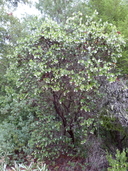Taxon Report
Arctostaphylos andersonii GrayAnderson's manzanita |
 © 2018 Jason Matthias Mills |
Taxon Summary
Arctostaphylos andersonii, commonly known as Anderson's manzanita, is a perennial evergreen shrub in the Ericaceae that is found only in California. It occurs within Broadleafed upland forest, Chaparral, and North Coast coniferous forest, growing at elevations from 60 to 760 meters. Arctostaphylos andersonii is ranked 1B.2, Plants Rare, Threatened or Endangered in California and Elsewhere; Moderately threatened in California.Classification
|
Scientific Name: |
Arctostaphylos andersonii Gray |
|
Common Name: |
Anderson's manzanita |
| Family: | Ericaceae |
| Element Code: | PDERI04030 |
| USDA Plants Symbol: | ARAN2 |
|
Synonyms/Other Names: |
|
Ecology and Life History
| Lifeform: | perennial evergreen shrub |
| Blooming Period: Nov-May | Nov-May |
| Elevation: | 60-760 (195-2495) |
| General Habitats: | Broadleafed upland forest, Chaparral, North Coast coniferous forest |
| Microhabitat: | Edges, Openings |
| Microhabitat Details: |
Conservation Status
| CA Rare Plant Rank: | 1B.2 |
| Global Rank: | G2 |
|
State Rank: |
S2 |
| State List: | None |
| Fed List: | None |
| Other Status: | SB_CalBG/RSABG; SB_UCSC |
|
CRPR Changes: |
|
Occurrence Data from the CNDDB
| Total Occurrences: | 64 |
| Element Occurrence Ranks: | |
| Excellent (A) | 5 |
| Good (B) | 12 |
| Fair (C) | 12 |
| Poor (D) | 6 |
| None (X) | 1 |
| Unknown (U) | 28 |
| California Endemic: True | |
| California Counties and Islands: Name (Code) | |
| San Mateo (SMT), Santa Clara (SCL), Santa Cruz (SCR) | |
| Quads: Name (Quad Code) | |
| Big Basin (3712222), Davenport (3712212), Felton (3712211), Franklin Point (3712223), La Honda (3712233), Laurel (3712118), Loma Prieta (3712117), Mt. Madonna (3712116), Santa Cruz (3612281), Soquel (3612188), Watsonville East (3612186), Watsonville West (3612187), Woodside (3712243) | |
Threat List Data from the CNDDB
| Threat List Total: | 11 | |
| EOs with Threat Listed: | Total EOs | % of EOs |
| 30 | 47 % | |
| Other | 14 | 21% |
| Road/trail construction/maint. | 14 | 21% |
| Logging | 11 | 17% |
| Non-native plant impacts | 5 | 7% |
| Development | 3 | 4% |
| Wood cutting or brush clearing | 3 | 4% |
| Biocides | 1 | 1% |
| Erosion/runoff | 1 | 1% |
| Foot traffic/trampling | 1 | 1% |
| Improper burning regime | 1 | 1% |
| Recreational use (non-ORV) | 1 | 1% |
Selected References
| Proceedings of the American Academy of Arts and Sciences 11:83 (1876) |
| North American Flora 29:98 (1914) for additional information |
Citation
California Native Plant Society, Rare Plant Program. 2025. Rare Plant Inventory (online edition, v9.5.1). Website https://www.rareplants.cnps.org [accessed 18 December 2025].